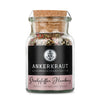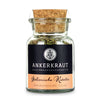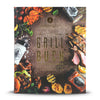An unbeatable duo: cinnamon & sugar
It is probably one of the most famous spice mixtures in every kitchen: aromatic cinnamon in red-brown together with snow-white sugar crystals - simply wonderful, and not just visually! Our cassia cinnamon and cane sugar ensure a fantastic taste, especially on sweet main courses or desserts such as pudding and rice pudding.
Only the best cane sugar and cinnamon go into our sustainable cork jar, together they make around 100 g of sugary love for sprinkling and refining your best dishes. There are guaranteed to be no frills, unnecessary flavors or additives in the jar: just the two delicious, tasty, gourmet ingredients.
The most popular use of the spice pair is and remains semolina porridge or rice pudding. The quickly prepared dishes don't have much of their own flavor, so a pinch of the unbeatable duo is just right to bring out and emphasize the best of the taste. Simply stir in directly during the cooking process and/or sprinkle over the filled plate as a brownish topping. But supposedly hearty classics like pasta can also be enjoyed with cinnamon and sugar: simply cook the pasta with the two spices, milk and a pinch of salt and then sprinkle it again with the seasoning mixture - done.
The right ratio: This is how it is mixed
Christmas baking in particular has become an indispensable part of Christmas baking without the two flavor wonders of cinnamon and sugar. The heavenly combination of the two seasonings should not be missing in almost any winter pastry. But no pastry should taste either only sweet or only cinnamon, oh no: the composition should be properly balanced and perfectly coordinated so that both can be tasted and enjoyed.
But in what ratio do you best mix the two seasonings? Everyone has their own preferences and experiences. There are also recipes and formulas such as “for every 10 tablespoons of sugar there is 1 tablespoon of cinnamon” or the 1:1 mixing method, in which both ingredients are added in equal parts, which of course promises a very intense taste. At Ankerkraut you can rely on getting a well-seasoned mixture that leaves nothing to be desired.
So with our ready-mixed recipe you don't have to worry - and guess what? When it comes to choosing recipes to use the whole thing either! Because we are presenting you with two different ideas spooky Halloween crepes oder aber a special ice cream with tonka beans can be manufactured. Attention cinnamon bitches and sugar dolls: this could be something for you!
The historical background
Sugar cane, the origin of sugar as we know it today, is said to have its origins in India. A very long time ago it was probably Alexander the Great who brought sugar cane to the Mediterranean area. From there, the plant from the sweet grass family spread across the globe until the Arabs managed to extract the classic cane sugar from the long, solid sticks. The current name for the sweet substance is also said to come from the Arabic to Indian regions.
Because of its similarity in color and consistency to another very well-known spice, this very valuable and expensive seasoning was also called “the sweet one” at that time Salt“. The discovery of sugar beet changed this ratio somewhat and made sugar more affordable when it was grown on a large scale and later processed industrially. But what would sugar be without its intensive partner cinnamon? There is no substitute for it and it impresses with its very own, unique taste. While it was used “only” as a fragrance for a long time in the Mediterranean region, its abilities as a fragrance were also discovered in the early Middle Ages Spice. At this time, the Arabs are said to have started and expanded the trade in the high-quality export hit, and the world got to know and love the brown sticks, processed into fine powder. Little by little, the Arabs lost their monopoly on the cinnamon trade as other countries began to discover and trade cinnamon sticks.
Did you know that in ancient Rome people supposedly believed that cinnamon came from so-called “cinnamon birds”? Or can it be found at the bottom of certain bodies of water? Well, this spice is definitely legendary thanks to its fantastic taste! But what is the difference between the Cassia and the Ceylon variant? This lies in the origin: While the Ceylon cinnamon comes from Sri Lanka, the cassia version comes from China and differs externally in stick form only slightly noticeable in the thickness of the rolled up tree bark. “Tree bark, huh?” you ask? Well, cinnamon sticks are actually peeled, rolled up and dried pieces of bark from the Ceylon or Cassia tree. Who would have thought… ;-)



















